Digital video and visual development avenues are evolving at a furious pace and are constantly morphing into more practical, efficient communication mechanisms. As a result, live streaming apps have taken over the world, and their development is becoming more popular and demanding.
The constant and fast-paced growth of modern technological advancements significantly impacts how we interact with IT-powered products and shapes the way we consume digital content. Not too long ago, we were renting movies at Blockbuster, buying beta max cassettes, or waiting days for one video to download only to watch it over and over in medium-to-low quality. Now, we find digital content streaming apps, websites, and channels everywhere. They have become the criterion by which we measure quality video content and, as we guzzle them up like water, new ones keep popping up left and right as we milk them and then move on to the next app. There’s no denying it; we love to generate, share, and consume live visual content. However, we now perceive entertainment in new terms, and those terms are defined by how fast and efficiently we can access these streams of live visuals. So, now the time has come for app developers to lay down the law and bolster live streaming app development, so the visual entertainment landscape keeps evolving and changing how we access digital content.
Still, the evident technological advancements in terms of mobile phone cameras, ease of internet access, and video streaming-oriented social media apps have brought on a spike in the demand for faster, better live streaming services. In other words, live video will undeniably take over the internet. So naturally, this takeover means that app developers must enforce practices that allow them to ship robust, innovative, and durable live streaming videos apps, which is no easy feat, but that’s what this article is all about.
Going by our experience as experienced and awarded app developers, we will try to outline the main concepts relevant to live streaming app development and, hopefully, guide you in your quest for developing your own live streaming app. So, let’s start then.

What is a live streaming app?
As its name implies, a live streaming app is an application that allows you to simultaneously capture, share, and broadcast real-time live streaming visual content. Their primary purpose, in that sense, is to record live media and publish it simultaneously. This timely broadcasting allows users to access content and watch it in real-time on televisions, computers, smartphones, tablets, and any other internet-powered device that can transmit video. In addition, users can interact with the broadcaster, comment, and share their opinions while watching the live streaming event. These characteristics, and their benefits, undeniably powered by the pandemic, have skyrocketed the popularity of live streaming apps. Statistics show that people spent almost 483 billion hours on live-streaming apps in the year of the pandemic! Additionally, in 2021, one-third of users worldwide claim to have spent up to five weekly hours on video streaming platforms, which is no surprise considering the live streaming market is expected to reach $223.98 billion by 2028. The advancements have undoubtedly catapulted this growth in camera technologies, social media proliferation, and high-speed internet protocols such as 5G.
Although most of them started as simple streaming services, modern live-streaming apps have burgeoned and are now full-blown platforms with millions of users and substantial market shares. They have, in fact, become so popular that there are now several different offerings on the market. Here are some of the different flavors of live-streaming apps available:
Live broadcasting apps: These are the most popular types of live-streaming apps. Users can find real-time videos of other users playing games, singing, dancing, discussing several topics, working out, etc. The most popular live broadcasting apps are Twitch, Instagram Live, Facebook Live, Livestream, and Periscope.
Live audio streaming apps: The principle is simple: users listen to music or spoken streaming audio files such as podcasts in real-time without having to download any of the audio files. Spotify, Apple Music, and Pandora are the most popular audio streaming apps on the market.
Video-on-demand (VoD) streaming apps: The most revolutionary app type on this list, VoD streaming apps are the ones we use to watch movies or television shows without downloading them on our devices. VoD apps stand out because the content isn’t live, allowing you to pause, stop, and resume it as you wish, and you usually have to pay a membership subscription to access it. Netflix, HBO Max, and Hulu are some famous examples of VoD streaming apps.
Live streaming apps have become so popular that they keep expanding in both service portfolios and focus areas. Users can now watch sports, follow fitness programs, watch other users play online games, watch cooking shows, enjoy dancing and singing challenges, and even watch genuine product reviews. And even though these are the main types of live-streaming apps, there are also apps like Skype and Zoom, which since the pandemic, have started to serve as private live-streaming apps where only authorized users have access. At the same time, other live streams are public and accessible for everyone. There are also healthcare streaming apps where users can access telemedicine services, which are usually one-on-one but also bolster the benefits of live streaming technology to broaden the reach of medical services.
Live streaming app development: essential components
Opening an app and clicking on a video that immediately opens and starts playing sounds as convenient and straightforward as it gets. And that’s how users see it: open, watch, enjoy. But how does that process work on the backend of the app? Several components go into successful live streaming app development. Specific implementations and components are paramount for these types of apps regardless of the kind of live streaming app or development methodology. Here are the most important ones.

HTML 5 Player
For decades, if you wanted to watch a video online, you had to download a third-party plugin like the Flash player; there was no other option. Thankfully, a new hypertext markup language (HTML) standard was developed, and HTML5 was born to allow for instant audio and video native playback, via a video tag, without the need to download any plugins or pay any fees. As a result, an HTML5 player is exceptionally beneficial for modern live-streaming apps:
- Because it works seamlessly across all web, iOS, and Android applications, it enables code reusability and significantly reduces development time.
- The HTML5 player’s user interface is also reusable, helping save time and ensure a consistent user experience across all the mobile and web platforms where the app runs.
- An HTML5 player is also very versatile, easily implemented, and efficient.
As a result, an HTML5 player requires significantly less development work, reducing the time-to-market and making updates easier to implement since they can be made server-side. In a nutshell, an HTML5 player makes live streaming app development more efficient and makes the application more usable and productive.
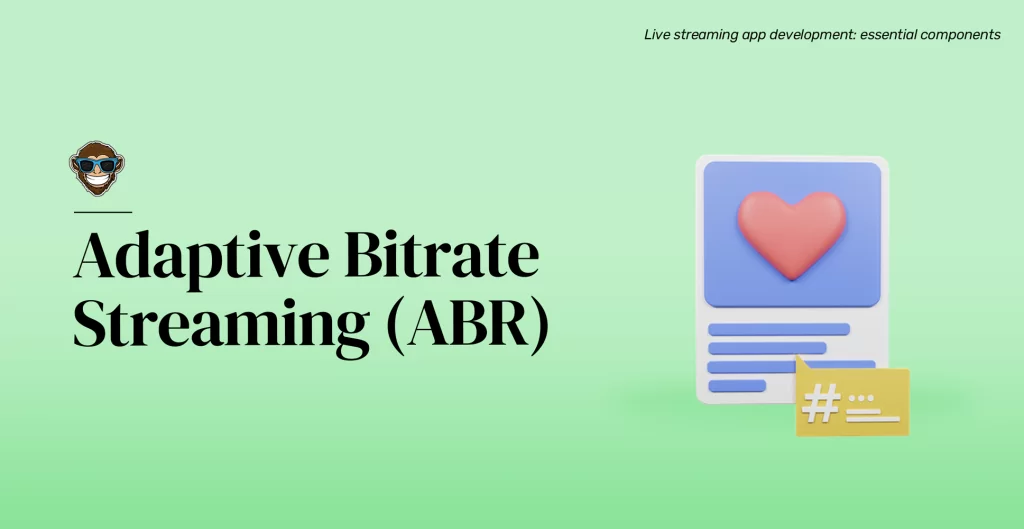
Adaptive Bitrate Streaming (ABR)
Live streaming apps fulfill their purpose only when they provide the best, highest quality, and most fluid live streaming experience for their users. If a video takes forever to upload, takes too long to buffer, or plays in low quality, then the point of live streaming is lost. Here’s where adaptive bitrate streaming (ABR) comes in. ABR is a crucial component of any live streaming app because it works with algorithms that determine the best bitrate segments to download depending on a user’s device and the speed of their internet connection. These video segments are used in streaming setups to enable video players to transmit data more efficiently. In other words, ABR streaming helps dynamically adjust the compression level and video quality of streams, which is often measured in kilobits per second (kbps), so that they can quickly adapt segments to different bandwidths fluctuations in internet speeds and screen sizes. To accomplish this level of “customization” of the streaming content, the video player identifies variations in the speed of internet connections and CPU capacities to upgrade or downgrade the stream’s bitrate. As a result, the streaming content is highly usable. Even those users with poor internet speeds or reduced screen sizes can still enjoy the perks of live streaming without long buffering times or pixelated videos.
Additionally, ABR streaming has a scalable architecture that allows the video player to escalate video quality according to its information. So, when a user first starts playing a video, ABR helps the system request the lowest bitrate file available, and if the device can handle a higher bitrate, it will select it and play it. This process takes place as many times as necessary until the video player finds the highest quality possible for that specific device. And the best part? ABR streaming technology memorizes this process and keeps selecting that bitrate until the conditions of the internet speed or device capabilities change. In that sense, ABR streaming is one of the most crucial components of modern live-streaming apps because it ensures that all users get the best quality video content possible, even when the device and internet connection aren’t ideal. Thus, developers can make sure their live streaming app reaches as many users as possible while maintaining user experience and accessibility always at the forefront.
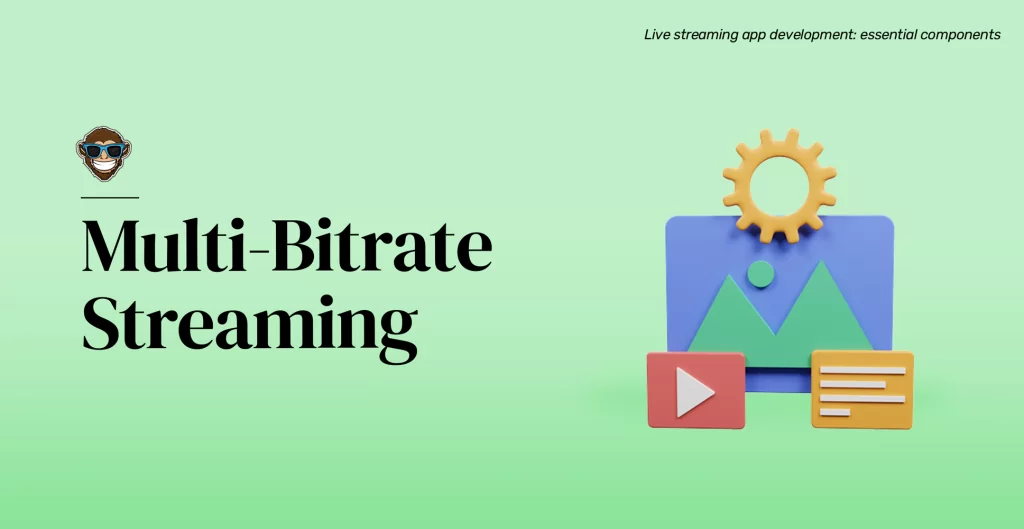
Multi-Bitrate Streaming
While ABR automatically adapts to different connection speeds and device characteristics to showcase the best version of a video, multi-bitrate streaming, or MBR, functions a tad differently. In MBR streaming, a video stream is encoded and configured in multiple bitrates. The viewer selects whichever stream better suits their needs, connections, and device to ensure the best possible video quality. And to make this choice more manageable for the user, the different streaming bitrates are labeled according to their specifications and bitrate depth (high, medium, or low) or resolution (1080p60, 720p60, 480p, 240p, etc.). Moreover, suppose for whatever reason a user chooses to play a video without choosing the best streaming options. In that case, the player’s system performs a diagnostic to determine the most suitable bitrate to ensure the best possible video quality. However, unlike ABR, in MBR, the video quality doesn’t adapt automatically, and the content continues to play in the chosen bitrate specifications even if the connection experiences fluctuations.
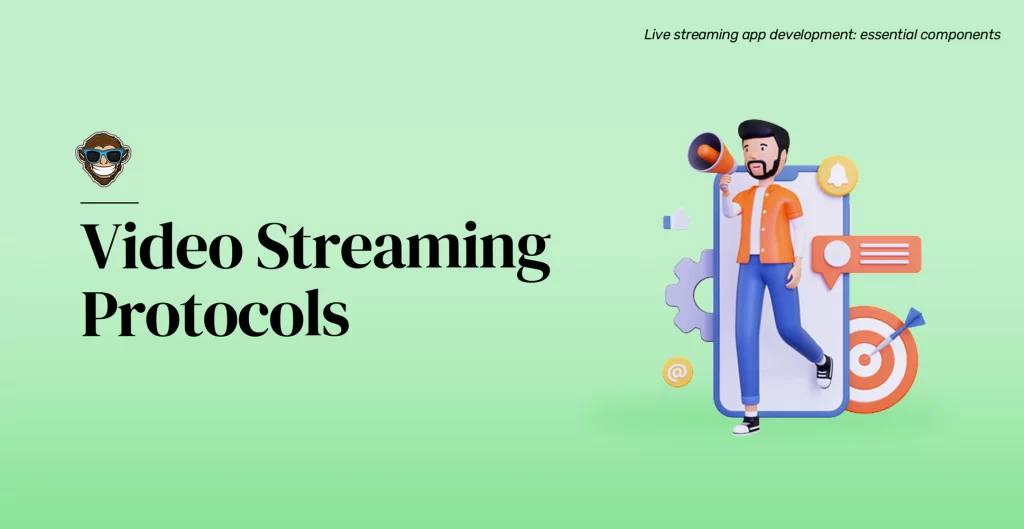
Video Streaming Protocols
A video streaming protocol is a collection of rules that govern how video data travels between two communicating systems (in this case, the broadcaster and the user) across the internet. In that sense, a video streaming protocol is essential for any live streaming application. In addition, it acts as a standardized delivery method for video segmentation, allowing the stream to “travel” in smaller chunks, reach the user’s device, and reassemble once it reaches it to enable sequential playback.
There are different video streaming protocols with different capabilities, and each serves a purpose, which is why thorough research is needed to make an informed selection. For instance, some protocols can support ABR, while others can’t. Some suffer from latency issues and work with legacy standards, while others work via open-source frameworks and are more efficient. Many others aren’t widely adopted yet and require more skills, while others are commonplace and easier to implement. Whichever the case, it’s paramount to understand what each protocol can do and how it can adapt to the devices and internet specifications under which it will perform. Here are some of the most common and robust video streaming protocols on the market:
HTTP Live Streaming (HLS): The most common and widely used video streaming protocol, HLS, was developed in 2009 by Apple for iOS. However, it is now compatible with all iOS and Android devices, from tablets to televisions, and HTML5 players, allowing HLS to reach a broader audience. Additionally, it supports adaptive bitrate streaming, making it the most scalable and secure video streaming protocol on the market.
Real-Time Messaging Protocol (RTMP): A veteran video streaming protocol, RTMP was developed by Macromedia and acquired by Adobe later on. Despite its old age, RTMP is still one of the most popular and universally accepted protocols because it was designed to support low latency transmissions, which, as we all know, is a crucial aspect of live video streaming. However, despite its benefits, RTMP was designed to work primarily with Adobe’s Flash player, which negatively impacted its usability when Adobe ended support for its famous player in 2020. RTMP is still viable when encoded to reach its destination via another protocol, usually HLS. However, experts say it is destined to become obsolete.
Secure Reliable Transport (SRT): SRT is a free, open-source, and new streaming protocol that provides low latency, high-quality video streaming even over low, congested, or poor network conditions. As a result, SRT is considered one of the most robust and secure streaming protocols on the market capable of competing with RTMP. Moreover, SRT can operate seamlessly regardless of how it is encoded and enables interoperability with any streaming workflows and technologies.
Web Real-Time Communications (WebRTC): WebRTC is a free and open-source protocol known for having the fastest video and audio streaming capabilities of any other protocol on the market. With near-zero latency, WebRTC was designed to support VoIP. It is the most used protocol for peer-to-peer video and audio live streaming applications, which is why its popularity grew during the pandemic. However, its advantages are also its flaws, and the fact that it works so well for video conferencing makes it non-scalable and non-usable in different scenarios.
As you can see, streaming protocols are a crucial part of live streaming app development, and these are just some of the most prominent ones. However, each comes with its own requirements and implementations, so choosing which one is best for live streaming app development depends on each application’s specifications and the market’s needs.
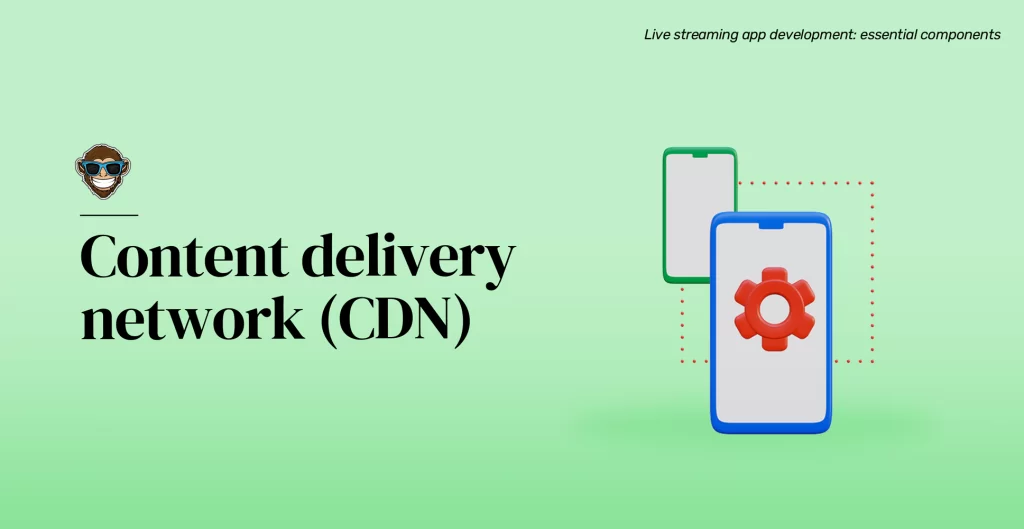
Content delivery network (CDN)
A content delivery network is a chain of servers geographically dispersed to expedite web content delivery, such as video, images, or text. CDNs, with the help of worldwide distributed data centers, can cache or temporarily store file copies in multiple locations to allow users to access streaming content via an internet-enabled device faster through nearby servers. In other words, CDNs place streaming content as close as possible to its viewers to save them the hassle of waiting for the content to load. Think of CDNs like an ATM. You can easily withdraw cash or make payments in your nearest location without going to the bank’s branch and waiting in line. The same happens with CDNs. Users simply request a video stream, and the application will use the CDN service to find the nearest server to support the content streaming to that user’s device.
CDNs aren’t mandatory for live streaming app development, but they are highly beneficial if you want to provide users with the immediacy inherent to these types of apps. For example, CDNs can optimize video loading times by moving the streaming source closer to the user, enhancing the app’s user experience, and ensuring a seamless viewing experience. Additionally, CDNs can also help solve network congestion problems that sometimes come with high-quality content streaming, such as high-definition graphics and top-quality video. And, as if that weren’t enough, CDNs can also enhance the app’s security measures and provide increased protection against hackers and malicious attacks.
Some live streaming app development companies choose to create and implement their CDNs in-house but doing so only works if they plan to have a reduced video catalog. Building their own CDN doesn’t make much sense for more significant projects and high-traffic live-streaming apps such as Tik Tok or Instagram Live. So, instead, they use CDN providers that can provide an instant, such as Stackpath, Cloudflare, or Google’s Cloud CDN.
Video Streaming Codecs
It is crucial to ensure the data transits at the fastest possible speeds in video streaming apps to enable live video transmissions and maintain the user experience as seamless as possible. RAW video files are very rich and high-quality, but they are also cumbersome and bulky and can easily take up enough data space to avoid the fast transfer. And while the RAW video may be helpful in other scenarios, it is a massive complication in live-streaming apps because at-home devices and personal internet connections aren’t powerful enough to handle the unwieldy burden of RAW files. Thankfully, we have codecs. A codec is a compression technology that reduces the size of a RAW file to the point where it can be easily transmitted and streamed. They apply compression algorithms to create a “copy” of the original file and discard any unnecessary data (such as equal video frames) to shrink down the size of the video during transmission so that once it reaches its destination, it can be decompressed and viewed by the end-user.
Codecs are a non-negotiable component of live streaming app development. Without them, video files coil simply not travel in real-time to the end-user, and the live feed wouldn’t be…well, live! So, implementing codecs is a must. Luckily, there is a wide variety of codecs available that adapt to different needs and any type of live streaming app out there. Here are the most used ones:
H.264/AVC: The most widely used codec, H.264, also known as AVC (Advanced Video Coding), is supported by every device and operating system on the market. It swiftly delivers high-quality video, and it is the most recommended codec for web and mobile live streaming applications.
VP9: Developed by Google, VP9 is a free and open-source codec that generally performs just as well as H.264 with the drawback that it is not compatible with as many OS and devices as its counterpart.
AV1: This innovative, modern codec comes from the joining of forces between Amazon, Netflix, Google, Microsoft, Cisco, and Mozilla, known as the Alliance for Open Media (AOM). AV1 is a royalty-free alternative to most codecs that provides practical, accessible, high-quality video streams. It is considered a better version of H.264 and other popular codecs, but its benefits are still debatable because it is a very young, experimental codec.
Aside from all the components listed in this article and others we may have missed, live streaming app development also requires most of the steps and considerations you would include in building any other type of product. In that sense, conducting thorough user research, establishing a budget, outlining your company and your product’s goals, and drawing out a game plan are essential steps to understand the type of live streaming app or MVP you need to create. Additionally, depending on your user research, you need to plan what features and implementations your live streaming app needs to meet your users’ needs and excel on the market. Some of the most common features of live-streaming apps are:
- Sign up/Log in
- User profile
- Payment systems for subscriptions
- Feed
- Chat and messaging
- Screen sharing
- Notifications
- Commenting and rating system
- Storage capabilities
- Advanced search functionalities
- Recommendations based on preferences
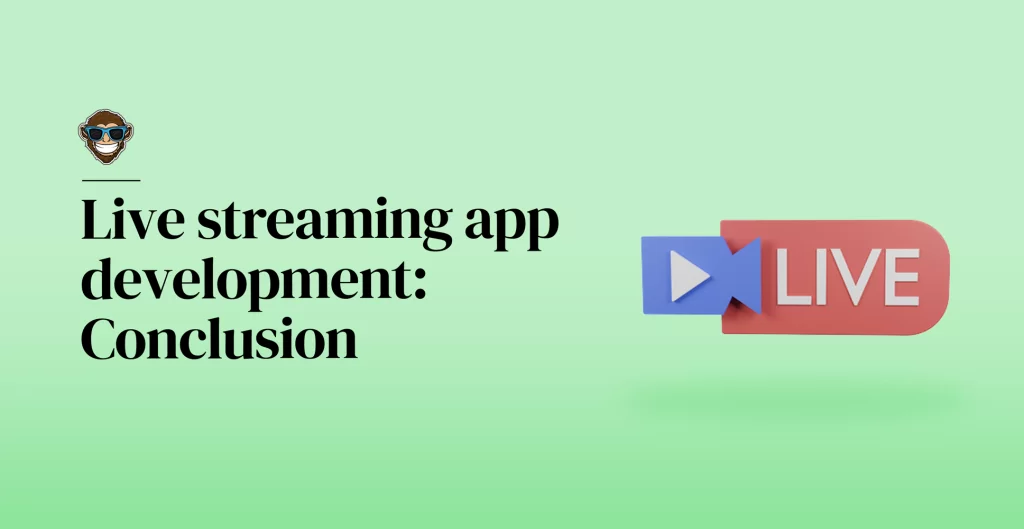
Live streaming app development: Conclusion
As mobile technology becomes more efficient and necessary, more and more businesses and people are starting to move their day-to-day to remote work, mobile apps, and internet-powered devices that grant the mobility we all need to function. Staying in touch is no longer a physical matter, and entertainment is becoming more about what we can find online rather than what we can do outdoors. As a result, live streaming apps are becoming essential for business and pleasure alike. As a result, live streaming app development is becoming a more competitive segment. Therefore, it is critical that developers understand and master the technologies and implications behind these types of apps so we can consistently deliver robust and durable live streaming products.
So, depending on your individual business goals, your budget, and your users’ needs, selecting the right components for your live streaming app may imply extensive research and a comparison between all the components, specifications, and features available to you to make an informed decision. And once you’ve made that decision, you can enforce all the recommendations and insights we’ve tried to line out in this article to help you in your live streaming app development process.
Still, if we didn’t manage to convey everything and you have further questions or concerns, please don’t hesitate to contact us so we can keep helping you and, hopefully, work together sometime in the future.
